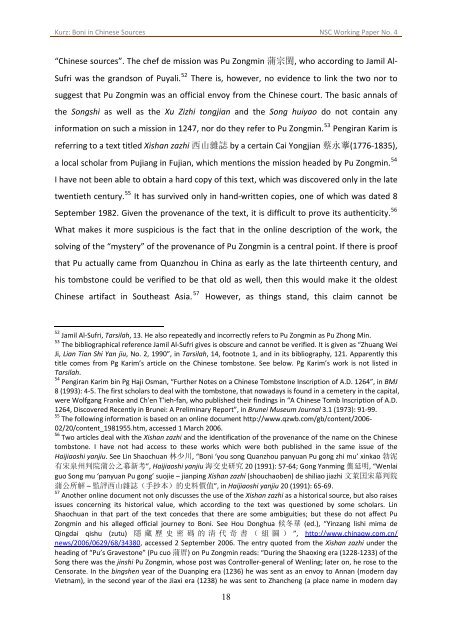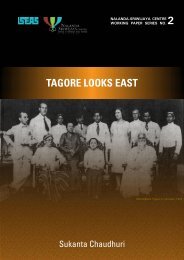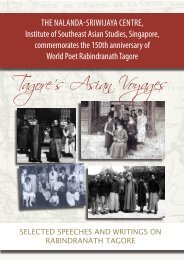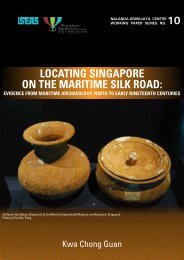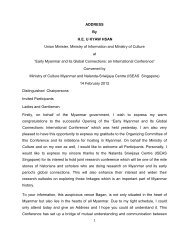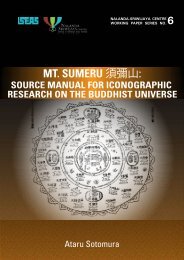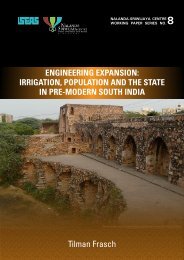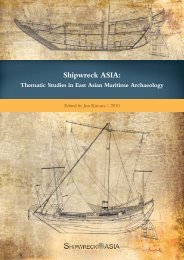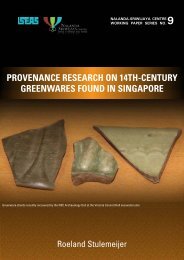Boni in Chinese Sources - Nalanda-Sriwijaya Centre - iseas
Boni in Chinese Sources - Nalanda-Sriwijaya Centre - iseas
Boni in Chinese Sources - Nalanda-Sriwijaya Centre - iseas
You also want an ePaper? Increase the reach of your titles
YUMPU automatically turns print PDFs into web optimized ePapers that Google loves.
Kurz: <strong>Boni</strong> <strong>in</strong> Ch<strong>in</strong>ese <strong>Sources</strong> NSC Work<strong>in</strong>g Paper No. 4“Ch<strong>in</strong>ese sources”. The chef de mission was Pu Zongm<strong>in</strong> 蒲 宗 閩 , who accord<strong>in</strong>g to Jamil Al‐Sufri was the grandson of Puyali. 52 There is, however, no evidence to l<strong>in</strong>k the two nor tosuggest that Pu Zongm<strong>in</strong> was an official envoy from the Ch<strong>in</strong>ese court. The basic annals ofthe Songshi as well as the Xu Zizhi tongjian and the Song huiyao do not conta<strong>in</strong> any<strong>in</strong>formation on such a mission <strong>in</strong> 1247, nor do they refer to Pu Zongm<strong>in</strong>. 53 Pengiran Karim isreferr<strong>in</strong>g to a text titled Xishan zazhi 西 山 雜 誌 by a certa<strong>in</strong> Cai Yongjian 蔡 永 藆 (1776‐1835),a local scholar from Pujiang <strong>in</strong> Fujian, which mentions the mission headed by Pu Zongm<strong>in</strong>. 54I have not been able to obta<strong>in</strong> a hard copy of this text, which was discovered only <strong>in</strong> the latetwentieth century. 55 It has survived only <strong>in</strong> hand‐written copies, one of which was dated 8September 1982. Given the provenance of the text, it is difficult to prove its authenticity. 56What makes it more suspicious is the fact that <strong>in</strong> the onl<strong>in</strong>e description of the work, thesolv<strong>in</strong>g of the “mystery” of the provenance of Pu Zongm<strong>in</strong> is a central po<strong>in</strong>t. If there is proofthat Pu actually came from Quanzhou <strong>in</strong> Ch<strong>in</strong>a as early as the late thirteenth century, andhis tombstone could be verified to be that old as well, then this would make it the oldestCh<strong>in</strong>ese artifact <strong>in</strong> Southeast Asia. 57 However, as th<strong>in</strong>gs stand, this claim cannot be52 Jamil Al‐Sufri, Tarsilah, 13. He also repeatedly and <strong>in</strong>correctly refers to Pu Zongm<strong>in</strong> as Pu Zhong M<strong>in</strong>.53 The bibliographical reference Jamil Al‐Sufri gives is obscure and cannot be verified. It is given as “Zhuang WeiJi, Lian Tian Shi Yan jiu, No. 2, 1990”, <strong>in</strong> Tarsilah, 14, footnote 1, and <strong>in</strong> its bibliography, 121. Apparently thistitle comes from Pg Karim’s article on the Ch<strong>in</strong>ese tombstone. See below. Pg Karim’s work is not listed <strong>in</strong>Tarsilah.54 Pengiran Karim b<strong>in</strong> Pg Haji Osman, “Further Notes on a Ch<strong>in</strong>ese Tombstone Inscription of A.D. 1264”, <strong>in</strong> BMJ8 (1993): 4‐5. The first scholars to deal with the tombstone, that nowadays is found <strong>in</strong> a cemetery <strong>in</strong> the capital,were Wolfgang Franke and Ch'en T'ieh‐fan, who published their f<strong>in</strong>d<strong>in</strong>gs <strong>in</strong> “A Ch<strong>in</strong>ese Tomb Inscription of A.D.1264, Discovered Recently <strong>in</strong> Brunei: A Prelim<strong>in</strong>ary Report”, <strong>in</strong> Brunei Museum Journal 3.1 (1973): 91‐99.55 The follow<strong>in</strong>g <strong>in</strong>formation is based on an onl<strong>in</strong>e document http://www.qzwb.com/gb/content/2006‐02/20/content_1981955.htm, accessed 1 March 2006.56 Two articles deal with the Xishan zazhi and the identification of the provenance of the name on the Ch<strong>in</strong>esetombstone. I have not had access to these works which were both published <strong>in</strong> the same issue of theHaijiaoshi yanjiu. See L<strong>in</strong> Shaochuan 林 少 川 , “<strong>Boni</strong> ‘you song Quanzhou panyuan Pu gong zhi mu’ x<strong>in</strong>kao 勃 泥有 宋 泉 州 判 院 蒲 公 之 幕 新 考 ”, Haijiaoshi yanjiu 海 交 史 研 究 20 (1991): 57‐64; Gong Yanm<strong>in</strong>g 龔 延 明 , “Wenlaiguo Song mu ‘panyuan Pu gong’ suojie – jianp<strong>in</strong>g Xishan zazhi (shouchaoben) de shiliao jiazhi 文 萊 囯 宋 幕 判 院蒲 公 所 解 – 監 評 西 山 雜 誌 ( 手 抄 本 ) 的 史 料 價 值 ”, <strong>in</strong> Haijiaoshi yanjiu 20 (1991): 65‐69.57 Another onl<strong>in</strong>e document not only discusses the use of the Xishan zazhi as a historical source, but also raisesissues concern<strong>in</strong>g its historical value, which accord<strong>in</strong>g to the text was questioned by some scholars. L<strong>in</strong>Shaochuan <strong>in</strong> that part of the text concedes that there are some ambiguities; but these do not affect PuZongm<strong>in</strong> and his alleged official journey to <strong>Boni</strong>. See Hou Donghua 候 冬 華 (ed.), “Y<strong>in</strong>zang lishi mima deQ<strong>in</strong>gdai qishu (zutu) 隱 藏 歷 史 密 碼 的 清 代 奇 書 ( 組 圖 )”, http://www.ch<strong>in</strong>aqw.com.cn/news/2006/0629/68/34380, accessed 2 September 2006. The entry quoted from the Xishan zazhi under thehead<strong>in</strong>g of “Pu’s Gravestone” (Pu cuo 蒲 厝 ) on Pu Zongm<strong>in</strong> reads: “Dur<strong>in</strong>g the Shaox<strong>in</strong>g era (1228‐1233) of theSong there was the j<strong>in</strong>shi Pu Zongm<strong>in</strong>, whose post was Controller‐general of Wenl<strong>in</strong>g; later on, he rose to theCensorate. In the b<strong>in</strong>gshen year of the Duanp<strong>in</strong>g era (1236) he was sent as an envoy to Annan (modern dayVietnam), <strong>in</strong> the second year of the Jiaxi era (1238) he was sent to Zhancheng (a place name <strong>in</strong> modern day18


